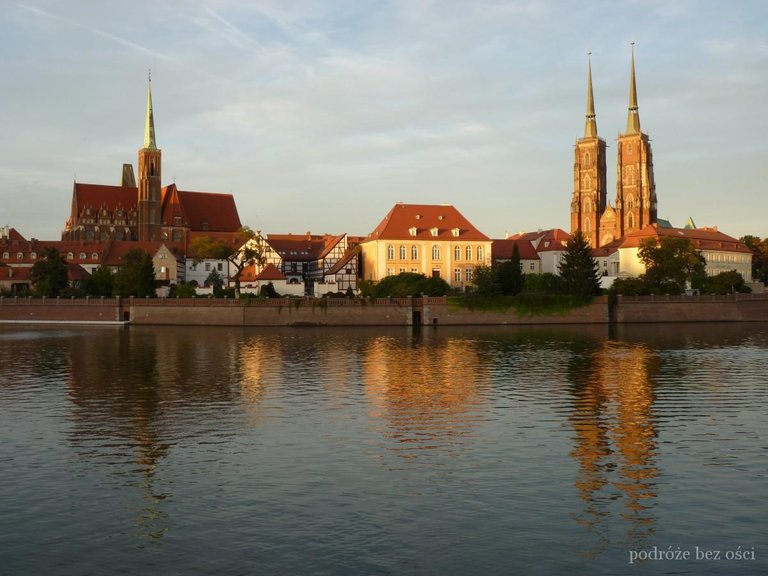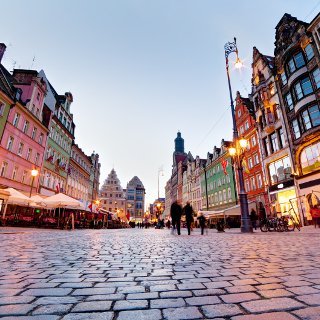In the Capital of Lower Silesia there are many attractions and places worth visiting. That is why Wroclaw attracts crowds of tourists who want to explore this fascinating city. But what is worth visiting if you have limited time? How to determine the priorities of the trip and what to focus on? Especially for visitors we have created a mini guide on: places, accommodation and moving around Wroclaw.
We will start with the most interesting ones, ie places that must be visited. Visiting the city usually starts from the center and we will also follow this standard trail. The center of Wroclaw brings together a lot of interesting objects and it is worth using this fact - especially when you have limited time to travel around the metropolis. Below we present our top list, which we have prepared based on the most optimal routes.
Wroclaw Market - if you are going to Wroclaw, you must necessarily see it! The market in Wroclaw is one of the largest in Europe. It is a rectangle with dimensions of 213 x 178 m. It has an area of 3.8 ha. This huge square is built in charming, colorful tenement houses from different periods. The Wrocław Market Square is a place that is crowded with both locals and tourists. Various urban events take place here, including In winter, the famous Christmas market and summer cinema in the open air. There is a large fountain at the Market Square, which perfectly fulfills its task on hot days, when the walkers feel the need to refresh themselves.
The market is also a cluster of bookshops, souvenir shops and many restaurants. A large selection of atmospheric cafes means that everyone will find delicious food here. You do not need any money to visit the beautiful Wrocław Market Square, but they will certainly be useful for souvenirs or a tasty dinner.
If you see the Market Square and regenerate yourself with good food, join the Pan Tadeusz Museum (Rynek 6). There is the only manuscript of "Pan Tadeusz" in the world, in the background of graphics, paintings and sculptures. The exhibition is complemented by multimedia presentations. The museum is open from Tuesday to Sunday from 10: 00-18: 00. Tickets cost 10/20 PLN. It's best to go here on Sunday. Why? Because then everyone will pay only PLN 1 for a ticket! You have to spend about 1.5 hours to visit the Pan Tadeusz Museum.
Option for lovers of museum exhibitions -> using the location in the Market, you can also visit other museums, which are located quite nearby, including Museum of Medallic Art and the Royal Palace in Wrocław (buildings at 35 Kazimierza Wielkiego Street) and the Archaeological Museum (9 Cieszyńskiego St.).

Neon Gallery at ul. Ruska 46C - this is a must see place. The courtyard, which is the most bright in Wroclaw, is located at ul. Ruska 46 (very close to the Market Square). Here are presented old neon signs from Wroclaw and Lower Silesia, which in the Gallery received a new life. Rus 46C is worth visiting at night, when neon signs look their best. The entrance is free.

Ostrów Tumski, a secluded and charming place that is best to see in the evening or at night. Ostrów has a long and interesting history, dating back over 1000 years. Initially, it was a stronghold stronghold of the Silesian Piast dynasty, and later it served as the center of the management of the Catholic church. Currently, it is an independent place, although it still retains its original historical character.
On Ostrów Tumski, you will see the historic St. Anthony Cathedral. John the Baptist, church of St. Cross and church of Saint. Giles. In addition to sacred buildings on Ostrów, there are mill bridges and the famous Tumski Bridge, called the Bridge of Lovers. On the latter pair hang padlocks with names, and the keys are thrown into the Oder. Lovers believe that this superstition is conducive to long-term happiness.
If you are lucky, maybe you will meet a lighthouse keeper at Ostrów, who will light gas lanterns. Do not be surprised how a crowd of people will appear around this man in a black cloak to ... take a picture with him. In Wrocław, the seemingly extinct lighthouse profession is very popular! Some even think that seeing a lighthouse man brings happiness. It is worth remembering that the lighthouse man walks at dusk only after Ostrów Tumski, the only place where there are gas lanterns. A walk around Ostrów is also a free
If you are more interested in the history of this extraordinary place, we refer you to the article in which you will find more information and a walking route - https://kochamwroclaw.pl/ostrow-tumski-dawniej-dzisa-trasa-spacerowa-mapa/
Cruises on the Oder. Boat trips and yachts on the river is a very interesting and pleasant way to explore the city. There are several marinas at the Odra river in the Oder: Kardynalska (Włostowica Boulevard, Piasek Island at Ostrów Tumski), Zwierzyniecka (Wróblewskiego 1, next to Zwierzyniec Bridge), ZOO Harbor - Japanese Gate (the second entrance to the Zoo behind the Terarium near the management), Przystań Hala Targowa (Boulevard of X. Dunikowski, near Hala Targowa) and Cypel (Wyspa Słodowa). Ships cycle regularly on cruises, which include follow the routes: Peace Bridge - National Museum - Provincial Office - Grunwaldzki Bridge - Water Tower - Śluza Szczytniki. In search of a dream cruise around Wroclaw, it is worth using the website http://www.statekpasazerski.pl/trasy-rejsow.html, where you can find specific information about all available cruises.

It is worth mentioning that sometimes there are promotions for cruises on the Odra - that's why we encourage you to look at www.groupon.pl. A cruise for one person can cost only PLN 10!
Wroclaw Zoo (Wróblewskiego Street 1-5) - it is one of the oldest zoological gardens in Poland, and at the same time only a place in the world, which has an aquarium dedicated to the fauna of Africa. Here you can see about 250 species of fish and an impressive underwater tunnel. In total, there are over 14 thousand. animals! To visit the zoological garden you have to spend an average of about half a day. Tickets cost PLN 35/45. It is worth saving your time and buying them online, because there are huge queues in front of the ticket offices! Especially when it's warm.

You will reach the ZOO by trams No. 1, 2, 4 and 10 or by buses No. 115, 145 and 146.
The zoological garden is quite close to the most famous work of Wrocław's modernism, the Hala Stulecia in Szczytnicki Park (Wystawowa 1 Street). This huge building was built in 1911-1913. His uprising was connected with the hundredth anniversary of the proclamation of the proclamation "To my people" (inciting to resistance against Napoleon Bonaparte) by Frederick William III. The anniversary was celebrated with a great exhibition in the Centennial Hall, which presented the history and achievements of Silesia. Later, the next exhibitions were hosted in the Hall. Before the Second World War, the Centennial Hall was also the venue of the NSDAP and Hitler officers' speeches. The object survived the war without major losses.
fot. Jarek Ciuruś Photography
The Centennial Hall is a point particularly frequented by tourists, including due to the proximity of the Multimedia Fountain, Pergola, ZOO and Japanese Garden. The hall also attracts tourists with interesting architecture and a multitude of various events that often take place in this huge complex. Important sports events of European and world rank are organized at the facility. Here take place such spectacles as the European Basketball Championships "EUROBASKET", TAURON Basket Liga and Wojak Boxing Night and many more. The complex also hosts trade fairs: work, construction, wedding, automotive or botanical. In addition, the hall is very popular due to numerous cultural and entertainment events, such as concerts, festivals, opera and theater performances. Multifunctionality of the complex also makes it also a place of various congresses, trainings, presentations and business
It is worth mentioning that in 2006 the Hala was declared a UNESCO World Heritage Site, which made the site even more elevated.
There is also a Japanese Garden in the Szczytnicki Park. It was founded in 1909-1913. For many years it has been beautified and supplemented with, among others for stone elements. The current shape of the Garden is owed to Polish and Japanese specialists. Japanese Garden in Wroclaw is the perfect place to relax or commemorative photo session. Omnipresent greenery and beautiful flowers have a soothing effect on all the senses. The garden is a small place, which does not take a lot of time to look at, but it is worth spending a long time to calm down in a beautiful environment.

A substitute of Japan in the Capital of Lower Silesia is best seen in spring or summer, when the period of flowering plants falls. We met with opinions that the Garden is the most beautiful in May.
Entrance tickets to the Japanese Garden cost a few zlotys.


